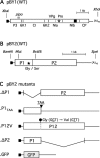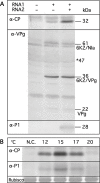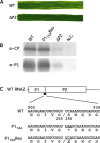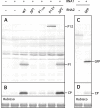Bymovirus reverse genetics: requirements for RNA2-encoded proteins in systemic infection
- PMID: 20447286
- PMCID: PMC6640240
- DOI: 10.1111/j.1364-3703.2010.00613.x
Bymovirus reverse genetics: requirements for RNA2-encoded proteins in systemic infection
Abstract
Barley yellow mosaic virus (BaYMV), the type species of the genus Bymovirus in the family Potyviridae in the picornavirus-like superfamily, causes a yellow mosaic disease of winter barley with significant yield losses in Europe and East Asia. Until now, infectious in vitro transcripts for the bipartite plus-sense RNA genome of any bymovirus species have not been available, rendering molecular analyses of bymovirus pathogenicity and the host resistance mechanisms difficult. In this study, we constructed the first cDNA clones of BaYMV RNA1 and RNA2, from which infectious RNA can be transcribed in vitro. Using in vitro transcripts, we showed that RNA1, which encodes eight proteins, including a viral proteinase NIa-Pro, the RNA-dependent RNA polymerase NIb, genome-linked viral protein VPg and the capsid protein CP, replicated autonomously in barley mesophyll protoplasts in the absence of RNA2 optimally at 15 degrees C, a temperature similar to the optimum for causing disease in barley fields. For systemic infection of barley plants, RNA1 alone was not sufficient and RNA2 was also required. Of the two proteins encoded on RNA2 (P1 with cysteine proteinase activity and P2 with unknown functions), P1 was essential and P2 was dispensable for systemic infectivity. The expression of both P1 and P2, but not the precursor polyprotein, together with RNA1 increased systemic infection and caused mosaic leaf symptoms. The infectious cDNA clones of BaYMV will be vital for future studies of bymovirus-host-vector interactions at the molecular level.
Figures





Similar articles
-
Association of VPg and eIF4E in the host tropism at the cellular level of Barley yellow mosaic virus and Wheat yellow mosaic virus in the genus Bymovirus.Virology. 2015 Feb;476:159-167. doi: 10.1016/j.virol.2014.12.010. Epub 2014 Dec 25. Virology. 2015. PMID: 25543966
-
The ability of a bymovirus to overcome the rym4-mediated resistance in barley correlates with a codon change in the VPg coding region on RNA1.J Gen Virol. 2003 Oct;84(Pt 10):2853-2859. doi: 10.1099/vir.0.19347-0. J Gen Virol. 2003. PMID: 13679620
-
Molecular analysis of Korean isolate of barley yellow mosaic virus.Virus Genes. 2006 Apr;32(2):171-6. doi: 10.1007/s11262-005-6873-5. Virus Genes. 2006. PMID: 16604449
-
Bymovirus-induced yellow mosaic diseases in barley and wheat: viruses, genetic resistances and functional aspects.Theor Appl Genet. 2020 May;133(5):1623-1640. doi: 10.1007/s00122-020-03555-7. Epub 2020 Feb 1. Theor Appl Genet. 2020. PMID: 32008056 Review.
-
Soil-borne viruses affecting cereals: known for long but still a threat.Virus Res. 2009 May;141(2):174-83. doi: 10.1016/j.virusres.2008.05.019. Epub 2009 Jan 19. Virus Res. 2009. PMID: 19159654 Review.
Cited by
-
Barley Yellow Mosaic Virus VPg Is the Determinant Protein for Breaking eIF4E-Mediated Recessive Resistance in Barley Plants.Front Plant Sci. 2016 Sep 30;7:1449. doi: 10.3389/fpls.2016.01449. eCollection 2016. Front Plant Sci. 2016. PMID: 27746794 Free PMC article.
-
Proteome expansion in the Potyviridae evolutionary radiation.FEMS Microbiol Rev. 2022 Jul 1;46(4):fuac011. doi: 10.1093/femsre/fuac011. FEMS Microbiol Rev. 2022. PMID: 35195244 Free PMC article. Review.
-
Rubisco small subunit (RbCS) is co-opted by potyvirids as the scaffold protein in assembling a complex for viral intercellular movement.PLoS Pathog. 2024 Mar 4;20(3):e1012064. doi: 10.1371/journal.ppat.1012064. eCollection 2024 Mar. PLoS Pathog. 2024. PMID: 38437247 Free PMC article.
-
The HC-Pro cistron of Triticum mosaic virus is dispensable for systemic infection in wheat but is required for symptom phenotype and efficient genome amplification.Virus Res. 2024 Jan 2;339:199277. doi: 10.1016/j.virusres.2023.199277. Epub 2023 Nov 30. Virus Res. 2024. PMID: 38008221 Free PMC article.
-
Recent progress in research on cell-to-cell movement of rice viruses.Front Microbiol. 2014 May 20;5:210. doi: 10.3389/fmicb.2014.00210. eCollection 2014. Front Microbiol. 2014. PMID: 24904532 Free PMC article. Review.
References
-
- Adams, M.J. , Swaby, A.G. and Jones, P. (1988) Confirmation of the transmission of barley yellow mosaic virus (BaYMV) by the fungus Polymyxa graminis . Ann. Appl. Biol. 112, 133–141.
-
- Adams, M.J. , Antoniw, F. and Mullins, J.G.L. (2001) Plant virus transmission by plasmodiophorid fungi is associated with distinctive transmembrane regions of virus‐encoded proteins. Arch. Virol. 146, 1139–1153. - PubMed
-
- Adams, M.J. , Antoniw, J.F. and Beaudoin, F. (2005) Overview and analysis of the polyprotein cleavage sites in the family Potyviridae . Mol. Plant Pathol. 6, 471–487. - PubMed
-
- Berger, P.H. , Adams, M.J. , Barnett, O.W. , Brunt, A.A. , Hammond, J. , Hill, J.H. , Jordan, R.L. , Kashiwazaki, S. , Rybicki, E. , Spence, N. , Stenger, D.C. , Ohki, S.T. , Uyeda, I. , Van Zaayen, A. , Valkonen, J. and Vetten, H. (2005) Family Potyviridae In: Virus Taxonomy. Eighth Report of the International Committee on Taxonomy of Viruses (Fauquet C.M., Mayo M.A., Maniloff J., Desselberger U. and Ball L.A., eds), pp. 819–841. San Diego, CA: Elsevier Academic Press.
Publication types
MeSH terms
Substances
LinkOut - more resources
Full Text Sources
Miscellaneous

